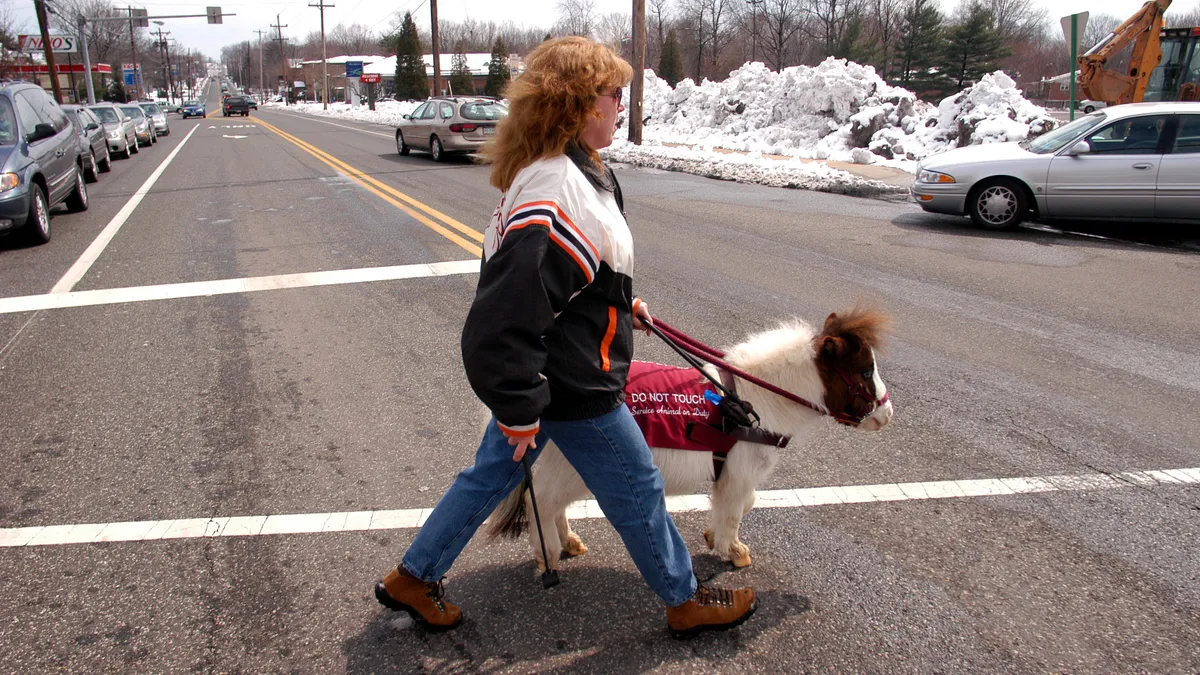Imagine you work for a dental office and oversee the waiting area. One morning, a patient, Laila, comes in with her service dog, a yellow lab. Laila sits down and begins leafing through a magazine, but soon realizes she recognizes another patient in the room — someone with whom she has an antagonistic relationship. The two begin arguing, and suddenly Laila's service dog starts to growl at the other patient.
What should you do?
This scenario is one of several complicated management situations a service animal could potentially pose for HR professionals, panelists at the U.S. Equal Employment Opportunity Commission Examining Conflicts in Employment Law conference noted June 15. With a strong understanding of just a few legal principles and a communicative approach, however, office managers can be well-prepared to handle almost any situation involving a service animal.
Service animals as "reasonable accommodation"
Service animals can be confusing because there are a patchwork of different laws that apply to them, said Sarah P. Williams, civil rights coordination and compliance section chief for the U.S. Health Resources and Services Administration (HRSA). Generally, all the relevant laws prohibit discrimination against people with disabilities and require accessibility for those people; so many exist because each law applies to a different setting.
For a private employer, service animal compliance generally falls under Title I of the Americans with Disabilities Act, which requires employers to provide reasonable accommodations to employees with physical or mental impairments, except in cases of undue hardship. The law is "very much the little sister of the Rehabilitation Act" of 1973, Williams said, which compelled federal employers to provide reasonable accommodations and was the first form of U.S. federal civil rights protection for individuals with disabilities.
Service animals should be approached and considered like any other reasonable accommodation, using the same means of discussion: the interactive process. Most employers will already be familiar with service dogs, so consider the miniature horse, the only other widely accepted service animal, according to Christina M. Fegley, HR specialist and service dog handler.
If an employee wants to bring their service mini horse into the office, they should notify their employer. If the employer does the proper analysis and determines, for whatever reason, that they cannot accommodate the mini horse, the interactive process does not end there, just as it continues with other reasonable accommodation requests. "The organization should ask, 'Is there another way we can assist you?'" Williams said.
If the employer and employee come up with an idea for accommodation that turns out not to work, that still isn't the end of the process, she said. "You still aren't done. You go back to the drawing board and re-engage in the conversation to determine whether there are other options that might meet the person's need."
Service animal or emotional support animal?
Most people can identify service animals on sight by their relationship with their handler, but there's no official documentation or identification — no legal registry or required certification — for service animals, said Katherine A. Slye-Griffin, ADAC accessibility section chief for the HRSA. "It can be tempting to focus on things like vests and IDs, but in the end, everything comes back to two questions," she said: Is the animal required because of a disability? And, what work or task has your animal been trained to perform?
If a person refuses to answer these questions, the employer or workplace manager has a right to refuse entry to the service animal, but the person must still be permitted to enter without the animal, Slye-Griffin said.
There are also certain questions workplace staff should avoid asking. If it is obvious from context that an animal is a service animal — in the case of a seeing-eye dog for an individual who is blind, for example — one should avoid asking questions about use of the dog, Slye-Griffin said. Staff should also not request documentation for service animals, request to see service animals perform tasks, or inquire about the nature or extent of a handler's disabilities.
Service animals differ from emotional support animals in both their level of training and the type of support they provide. While emotional support animals provide comfort, they are not trained to perform a specific job or task, and therefore are not considered service animals.
A person who has post-traumatic stress disorder and deals with nightmares, for example, would be awakened by a service dog, which would be trained to recognize and manage the situation. An emotional support dog would provide comfort and a sense of safety to the sleeper upon waking. "Only the service animal actively provides the specific assistance necessary to mitigate the disability," Slye-Griffin said.
Emotional support animals could be an "appropriate accommodation," Fegley said. But service animals "have become so firmly established as an effective modification or accommodation that they have their own standardized structure for how we interact with individuals who use them," Williams said.
Be flexible with reasonable accommodations
Under disability law, service animals can only be prohibited in cases of "undue hardship," in which providing the requested accommodation would be so administratively or economically burdensome as to put an organization at risk, or in which providing the requested accommodation would change the nature of the service or program. All panelists agreed that such a situation was so vanishingly rare, they had difficulty thinking of a good example. "The bar here is really high," said Slye-Griffin.
In most situations in which a service animal might pose a complication, a good solution is possible. For example, if a workplace provides services for program participants, and expects to meet on the same day with one who has a service dog and one who has an allergy to dog dander, the program manager could talk to the individuals and try to schedule them at different times, to ensure no interaction between the dog and the allergic individual.
If the two must be at the office at the same time, consider asking if one would like to go directly to the meeting room, while the other takes the appointment in the lobby, Williams suggested. "I want to caution ... that this should involve some conversation with [both] individuals, because we want to avoid automatically isolating someone with a disability," she added.
While employers should be creative and flexible with accommodations, they can rest assured such accommodations must still be reasonable. Williams introduced one scenario example of Carla, a woman who brought her service dog into a dining area, set him up in a chair and fed him at the table. A manager would be right to ask Carla to remove her dog from the chair in such a situation, she said; "generally, a service animal should blend into its surroundings."
When not to allow service animals
While workplaces should almost always be able to accommodate service animals, the panelists agreed there are certain situations in which their use can be denied. Consider the initial scenario of Laila, for example. In the exceedingly rare scenario when a service animal is threatening others, it can be categorized as a "direct threat" under the ADA, or a "significant risk to the health or safety of others that cannot be eliminated by reasonable accommodation." An office manager in such a situation would be wise to ask the patient to take the dog outside.
In general, a handler should be expected to control the service dog, meaning uncontrollable barking, jumping, snapping and other behaviors — while again, extremely rare — would be grounds to disallow the service dog on the premises. Minor incidents, such as a dog accidentally slipping from a harness and remaining by his handler as she re-harnesses him, should be regarded as acceptable. To warrant a dog's removal by the handler, it should be clear that the handler is unable to gain control of the dog.
In addition, certain environments require an extremely high degree of sterility and would be out of bounds for service dogs. In general, however, those areas are also off-limits to the general population, Williams said.
"Some people like to consider general patient care areas or self-serving cafeterias as sterile areas, and we like to hope those areas are very clean," she said. But service animals are very much allowed in such areas. "When we talk about sterile areas or threats to safety, we're talking about areas in which patients are incredibly vulnerable to infection, such as burn wards or active operating rooms."
As a gut check, Williams recommended asking yourself whether the general public would also be restricted from entry in a certain area. "Human beings are not sterile," she said. "But they are allowed in hospital rooms and cafeterias."




















